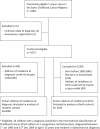Childhood cancer and nuclear power plants in Switzerland: a census-based cohort study
- PMID: 21750009
- PMCID: PMC3204210
- DOI: 10.1093/ije/dyr115
Childhood cancer and nuclear power plants in Switzerland: a census-based cohort study
Abstract
Background: Previous studies on childhood cancer and nuclear power plants (NPPs) produced conflicting results. We used a cohort approach to examine whether residence near NPPs was associated with leukaemia or any childhood cancer in Switzerland.
Methods: We computed person-years at risk for children aged 0-15 years born in Switzerland from 1985 to 2009, based on the Swiss censuses 1990 and 2000 and identified cancer cases from the Swiss Childhood Cancer Registry. We geo-coded place of residence at birth and calculated incidence rate ratios (IRRs) with 95% confidence intervals (CIs) comparing the risk of cancer in children born <5 km, 5-10 km and 10-15 km from the nearest NPP with children born >15 km away, using Poisson regression models.
Results: We included 2925 children diagnosed with cancer during 21 117 524 person-years of follow-up; 953 (32.6%) had leukaemia. Eight and 12 children diagnosed with leukaemia at ages 0-4 and 0-15 years, and 18 and 31 children diagnosed with any cancer were born <5 km from a NPP. Compared with children born >15 km away, the IRRs (95% CI) for leukaemia in 0-4 and 0-15 year olds were 1.20 (0.60-2.41) and 1.05 (0.60-1.86), respectively. For any cancer, corresponding IRRs were 0.97 (0.61-1.54) and 0.89 (0.63-1.27). There was no evidence of a dose-response relationship with distance (P > 0.30). Results were similar for residence at diagnosis and at birth, and when adjusted for potential confounders. Results from sensitivity analyses were consistent with main results.
Conclusions: This nationwide cohort study found little evidence of an association between residence near NPPs and the risk of leukaemia or any childhood cancer.
Figures





Comment in
-
Childhood cancer and nuclear power plants in Switzerland: a census-based cohort study.Int J Epidemiol. 2012 Feb;41(1):318; author reply 321-2. doi: 10.1093/ije/dyr211. Epub 2012 Jan 27. Int J Epidemiol. 2012. PMID: 22287129 No abstract available.
-
CANUPIS study strengthens evidence of increased leukaemia rates near nuclear power plants.Int J Epidemiol. 2012 Feb;41(1):318-9; author reply 321-2. doi: 10.1093/ije/dyr210. Epub 2012 Jan 27. Int J Epidemiol. 2012. PMID: 22287132 No abstract available.
-
Spike radiations near nuclear power plants may be the culprit.Int J Epidemiol. 2012 Feb;41(1):319-21; author reply 321-2. doi: 10.1093/ije/dyr209. Epub 2012 Jan 27. Int J Epidemiol. 2012. PMID: 22287133 No abstract available.
References
-
- Black D. Investigation of the Possible Increased Incidence of Cancer in West Cumbria; Report of the Independent Advisory Group. London: HMSO; 1984.
-
- Michaelis J, Keller B, Haaf G, Kaatsch P. Incidence of childhood malignancies in the vicinity of west German nuclear power plants. Cancer Causes Control. 1992;3:255–63. - PubMed
-
- Cook-Mozaffari P, Darby S, Doll R. Cancer near potential sites of nuclear installations. Lancet. 1989;2:1145–47. - PubMed
-
- Spix C, Schmiedel S, Kaatsch P, Schulze-Rath R, Blettner M. Case-control study on childhood cancer in the vicinity of nuclear power plants in Germany 1980-2003. Eur J Cancer. 2008;44:275–84. - PubMed
-
- Kaatsch P, Spix C, Schulze-Rath R, Schmiedel S, Blettner M. Leukaemia in young children living in the vicinity of German nuclear power plants. Int J Cancer. 2008;122:721–26. - PubMed

